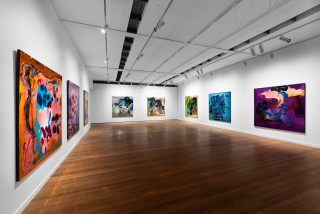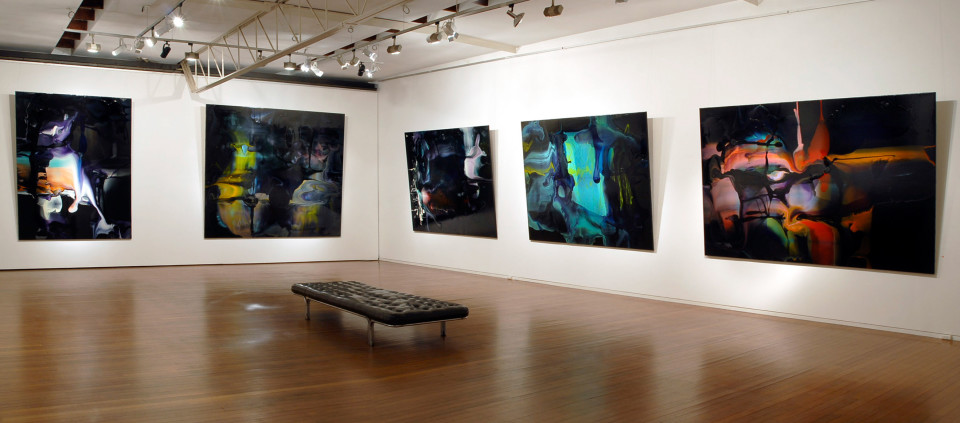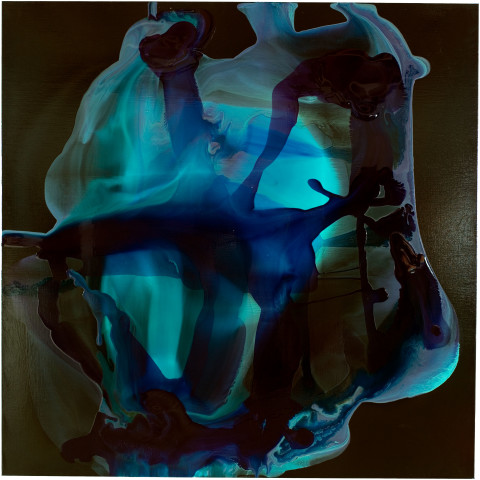Just as the Masaccio’s Trinity, (c. 1420’s) revealed the divine hierarchy spatially as an illusionary window in the nave of the church of S. Maria Novella, Dale Frank’s canvases reveal the order of the natural world through the physical expression of the second law of thermodynamics—the law of entropy.
Exhibition Dates: 26 June – 19 July 2008
‘The true artist helps the world by revealing mystic truths.’
—Bruce Nauman, 1967
The discovery of linear perspective in fifteenth century Italy, and the use of symmetry and harmony of proportion in the arts of ancient Greece two thousand years before then, exposes the human quest to reveal the highest truths of their society through the arts. In both of these cases mathematical principles were used to disclose divine order and divine perfection. The highest truths in society today are not theological, however, but theoretical in the form of the laws and principles of physics and the other sciences.
Just as the Masaccio’s Trinity, (c. 1420’s) revealed the divine hierarchy spatially as an illusionary window in the nave of the church of S. Maria Novella, Dale Frank’s canvases reveal the order of the natural world through the physical expression of the second law of thermodynamics—the law of entropy. One of two fundamental laws of physics that form the basis of all others, entropy explains how seemingly chaotic oppositions are brought into order. It is the law that shows how ‘the world acts spontaneously to minimise potentials.’ This, I argue, is revealed by the processes used by Frank in the production of his signature varnish paintings.
The world acts quickly to stem the potential of varnish. Our ambient air is denser than the toxic chemical solvents that keep it in its liquid form, so when this liquid is given a greater surface area, poured from a vessel onto the canvas, these volatile particles that threaten to burn the hand and eye of the artist push energetically upwards. But their violent expulsion into the air is soon sated as they dissipate into the atmosphere. So the world has an immediate effect on the potential of the varnish as the more of this solvent dissipates the more viscose the varnish becomes, and the less it can express its kinetic potential in terms of movement.
Frank takes advantage of the changing malleability of varnish during its transformation from liquid into solid, with the various stages of solidification shown by tinting the varnish brilliant colours. As one coloured liquid is poured onto another, a calculated reaction occurs based on the mass and viscosity of each. On top of a field of black already loaded with a variety of various coloured varnishes, each added with adequate time delay to prevent them loosing their integrity, the artist may add a vibrant vermilion green. Then by tilting or moving the canvas these liquids are forced to coalesce, the more mobile of them sitting on the picture surface. As they move, the colours blend or separate depending on their relative stage in the drying process, forming swirling liquid patterns that permanently fix like those of molten rock that once poured from a volcano now forming part of the geology of the landscape.
The analogy of lava is apt, as beneath the set surface of these works a quantity of varnish remains liquid, like the magma that dwells beneath the earth’s crust threatening to break through this fragile layer and transform the landscape once more. This is expressed in the bulbs of varnish that form a tense discourse with the surface layer, appearing pregnant with possibility, and occasionally defying gravity through reorientation of the support.
The artist has described his paintings as landscapes, and we can see why, the forms that are created are reminiscent of those found in the natural world. This is no coincidence. The very same law of entropy that guides the use of this artist’s materials also governs the formation of landscapes: the path of the river carved by millennia of torrents; the flat planes that buckled to form mountains during ancient tectonic movements; and all other geological formations carved and sculpted by the elements. Frank’s canvases are alien lands that obey the same universal laws of physics that have shaped the natural wonders of the earth. The artist acts like a benevolent deity in the creation of these worlds. More plausible than the Christian myth of our creation, his canvases are worlds that we can imagine being formed in seven days, through his decisive additions and adjustments: pouring, tipping tilting, to form their extraordinary landscape-like forms.
The relationship between the titles of these paintings and their visual forms is another kind of opposition analogous the physical oppositions found on the surfaces of these works; that of the opposition between the human mind and the physical world. The problem - at least as old as Cartesian dualism—is that the physical and psychological realms are necessarily distinct from one another, and Frank’s titles are as undeniably psychological as his paintings are physical.
Frank’s titles vacillate between the seemingly mundane in - Every Biro is empty - to the overtly profound with - In my annihilation I win, in my absence I win, in your indifference I win , in your exclusion I win, I win, I win as nothing is abstract not even in art. They illustrate a witty cynicism towards a lifestyle where torturous and hazardous creation can only turn out ‘Some Boring Paintings.’ But this belies the real effect of these disjunctive aphorisms; they expose the very problem of using language to elucidate art objects. These paintings and their titles need the viewer to bring them into union, to puzzle over their possible connections or disconnections. In this way, Frank exposes the inadequacy of the poetry that floats from the tips of the tongues of the arts community in a vain attempt to rationalise the ineffable qualities of the art object.
The incommensurability of objects formed by the human hand in accord with universal laws of physics, and our psychological reactions to them, is what gives great works of art their inexhaustible and lasting appeal. Just as the physicality of Frank’s canvases, met by his poetic obfuscations have let slip that these works are vessels of mystic truths—the work of a true artist.
—Robert Wellington, 2008
—
Dale Frank has been showing with Roslyn Oxley9 Gallery since 1982. His career spans more than twenty years. In 1983, he was included in the exhibition Panorama della post - critica: critica ed arte at the Museo Palazzo Lanfranchi in Pisa along with Thomas Lawson and Anselm Kiefer (curated by Helena Kontova). In 1984 he was included in the Aperto section of the Venice Biennale. Returning to Australia, in 1990 he was included in the 8th Biennale of Sydney (curated by Rene Block). A major solo retrospective of his work was held at the Museum of Contemporary Art, Sydney in 2000. His paintings are held in every major public collection in Australia and in numerous private and corporate collections in Australia, Europe and the U.S. In 2005 Frank won The Arthur Guy Memorial Painting Prize at the Bendigo Art Gallery, Victoria. A major new monograph on Frank’s work So Far: the Art of Dale Frank 2005-1980 was published in 2007.

varnish on canvas
200 x 300 cm

varnish on canvas
200 x 300 cm

varnish on canvas
260 x 300 cm

varnish on canvas
200 x 260 cm

varnish on canvas
200 x 260 cm

varnish on canvas
200 x 260 cm

varnish on canvas
200 x 260 cm

varnish on canvas
200 x 260 cm

varnish on canvas
200 x 260 cm

varnish on canvas
200 x 260 cm

varnish on canvas
200 x 260 cm

varnish on canvas
200 x 200 cm

varnish on canvas
200 x 200 cm

varnish on canvas
200 x 200 cm
 Dale Frank Alicia’s thirteen puppies in an old Adidas bag
Dale Frank Alicia’s thirteen puppies in an old Adidas bag
Roslyn Oxley9 Gallery, 2024
 Dale Frank Growers and Showers
Dale Frank Growers and Showers
National Art School, 2024
 Group Show, The First 40 Years
Group Show, The First 40 Years
Roslyn Oxley9 Gallery, 2024
 Dale Frank Jacob took seven minutes before he could piss
Dale Frank Jacob took seven minutes before he could piss
Roslyn Oxley9 Gallery, 2023
 Dale Frank this is a floatation device, this is not a life saving device
Dale Frank this is a floatation device, this is not a life saving device
Roslyn Oxley9 Gallery, 2022
 Dale Frank The Omega Variant Show
Dale Frank The Omega Variant Show
Roslyn Oxley9 Gallery, 2021
 Dale Frank Shaun taught piano
Dale Frank Shaun taught piano
Roslyn Oxley9 Gallery, 2020
 Dale Frank
Dale Frank
Roslyn Oxley9 Gallery, 2019
 Group Show, The Like Button
Group Show, The Like Button
Roslyn Oxley9 Gallery, 2018-19
 Dale Frank
Dale Frank
Roslyn Oxley9 Gallery, 2018
 Group Show, State of Play
Group Show, State of Play
Roslyn Oxley9 Gallery, 2017
 Dale Frank
Dale Frank
Roslyn Oxley9 Gallery, 2017
 Group Show, Shut Up and Paint
Group Show, Shut Up and Paint
National Gallery of Victoria, Melbourne, 2016-17
 Group Show
Group Show
Roslyn Oxley9 Gallery, 2016
 Dale Frank SABCO PEROXIDE
Dale Frank SABCO PEROXIDE
Roslyn Oxley9 Gallery, 2016
 Group Show
Group Show
Roslyn Oxley9 Gallery, 2015
 Dale Frank Toby Jugs
Dale Frank Toby Jugs
Roslyn Oxley9 Gallery, 2014
 Dale Frank Nobody's Sweetie
Dale Frank Nobody's Sweetie
Roslyn Oxley9 Gallery, 2013
 Dale Frank WACKY DUCK FLUFFY TOM
Dale Frank WACKY DUCK FLUFFY TOM
Roslyn Oxley9 Gallery, 2011
Dale Frank Charlie Cox
123 Albert Street, Brisbane, 2011
 Dale Frank Ice Age
Dale Frank Ice Age
Roslyn Oxley9 Gallery, 2010
 Dale Frank Some Boring Paintings
Dale Frank Some Boring Paintings
Roslyn Oxley9 Gallery, 2008
 Dale Frank Sore Throat
Dale Frank Sore Throat
Roslyn Oxley9 Gallery, 2007
 Dale Frank
Dale Frank
Roslyn Oxley9 Gallery, 2006
 Group Show
Group Show
Roslyn Oxley9 Gallery, 2005
 Dale Frank Modern Art Paintings For Sale
Dale Frank Modern Art Paintings For Sale
Roslyn Oxley9 Gallery, 2004
 Dale Frank Views from the Bruce Highway
Dale Frank Views from the Bruce Highway
Roslyn Oxley9 Gallery, 2003
 Group Show, Dirty Dozen
Group Show, Dirty Dozen
Roslyn Oxley9 Gallery, 2002
 Group Show, The First 20 Years
Group Show, The First 20 Years
Roslyn Oxley9 Gallery, 2002
 Dale Frank
Dale Frank
Roslyn Oxley9 Gallery, 2001
 Group Show, All Stars
Group Show, All Stars
Roslyn Oxley9 Gallery, 2000
 Dale Frank John Cougar Mellencamp A Sydney Lap Dog the Perfect Drug
Dale Frank John Cougar Mellencamp A Sydney Lap Dog the Perfect Drug
Roslyn Oxley9 Gallery, 2000
 Dale Frank A few paintings in the small room
Dale Frank A few paintings in the small room
Roslyn Oxley9 Gallery, 1999
 Dale Frank Paintings
Dale Frank Paintings
Roslyn Oxley9 Gallery, 1998
 Dale Frank MOVIE SHOW: new collage
Dale Frank MOVIE SHOW: new collage
Roslyn Oxley9 Gallery, 1997
 Dale Frank Pool room
Dale Frank Pool room
Roslyn Oxley9 Gallery, 1996
 Dale Frank Social Realism
Dale Frank Social Realism
Roslyn Oxley9 Gallery, 1996
 Group Show, Stockroom
Group Show, Stockroom
Roslyn Oxley9 Gallery, 1995
 Dale Frank I'm Only Dancing
Dale Frank I'm Only Dancing
Roslyn Oxley9 Gallery, 1995
 Dale Frank
Dale Frank
Roslyn Oxley9 Gallery, 1992
 Dale Frank Recent small drawings
Dale Frank Recent small drawings
Roslyn Oxley9 Gallery, 1992
 Group Show, Christmas show
Group Show, Christmas show
Roslyn Oxley9 Gallery, 1991
 Dale Frank Recent Work
Dale Frank Recent Work
Roslyn Oxley9 Gallery, 1991
 Dale Frank
Dale Frank
Roslyn Oxley9 Gallery, 1990
 Group Show
Group Show
Roslyn Oxley9 Gallery, 1990
 Dale Frank
Dale Frank
Roslyn Oxley9 Gallery, 1989
 Dale Frank
Dale Frank
Roslyn Oxley9 Gallery, 1986
 Group Show, The Forbidden Object
Group Show, The Forbidden Object
Roslyn Oxley9 Gallery, 1986
 Dale Frank
Dale Frank
Roslyn Oxley9 Gallery, 1985
Group Show, Australian Visions
Solomon R. Guggenheim Museum, New York, 1984
 Dale Frank Death
Dale Frank Death
Roslyn Oxley9 Gallery, 1984
 Group Show, Dreams and Nightmares
Group Show, Dreams and Nightmares
Roslyn Oxley9 Gallery, 1984
 Dale Frank Punchline
Dale Frank Punchline
Roslyn Oxley9 Gallery, 1983













